Early onset of hearing loss can impose substantial delays in communication and psychosocial development unless immediate and appropriate intervention is undertaken. The most obvious consequence of prelingual hearing loss is a decrease in the access to sound. Without maximal audibility, higher centers of auditory processing may receive stimuli devoid of important phonemic cues that contribute to speech understanding and language development. Even with optimum audibility, distortion of input may further affect recognition and comprehension. Development of spoken language for children with hearing loss requires the fitting of a sensory device followed by a well-designed habilitation program. The goal of prosthetic intervention is to maximize auditory capacity, thereby providing the sensory evidence necessary to perceive the acoustic cues of speech. We now have the tools to identify hearing loss at birth and to fit sensory devices soon thereafter. However, we are limited in the standardized behavioral tests required to assess auditory perceptual performance, particularly in babies from birth to 3 years of age.
The information required to assess higher level auditory processing and to appraise intervention outcomes depends, to a large extent, on speech perception data. According to Boothroyd (1991), speech perception is "the process by which a perceiver internally generates linguistic structures believed to correspond with those generated by a talker. (p.78)." Assessment of speech perception in the pediatric population is important for several reasons. First, results on speech perception measures help determine whether a child is benefiting from a hearing aid or should be considered for a cochlear implant. Although cochlear implants are approved for children 12 months of age and older, there is a growing trend in the United States to implant children under the age of 12 months (Luxford, Eisenberg, Johnson, & Mahnke, 2004), underscoring the need for measures that can be used with infants. Second, speech perception measures are important for comparing differences between sensory devices and/or processing algorithms. Third, follow-up assessments help track performance over time. Lastly, speech perception data in combination with speech and language outcomes are essential for establishing guidelines for habilitation.
In this overview, we highlight some of the important issues involved in speech perception assessment of hearing-impaired children with an emphasis on tests designed for children 3 years of age and younger. Illustrative cases are presented using several of these measures, including data from new implementations of established assessment techniques being developed at the House Ear Institute.
Considerations in Speech Perception Assessment
A number of important factors must be taken into consideration when assessing speech perception in children. These include a combination of child, task, tester, and environmental influences on test outcomes (Boothroyd, 2004). Child factors include the state of the child during testing, such as their attentiveness to the task. Moreover, children must demonstrate the requisite motor skills to perform the response task being asked of them (e.g., head turn, manipulation of objects, picture pointing, pushing a button), as well as the phonological, receptive and expressive language skills needed to participate in speech perception testing. Tester and environmental factors include the audiologist's aptitude to work with the pediatric hearing-impaired population, the general feel of the facility, and caregiver attitudes and behaviors.
Of those listed above, the task factors probably require the greatest consideration due to influences of maturation and language on test outcomes. A battery approach is needed to accommodate children of different ages (both chronological and linguistic), communication modes (oral vs. sign language), and auditory processing skills. For that reason, assessment batteries should include measures that vary from closed-set to open-set response formats, from live voice to recorded presentation, and from auditory-visual to auditory-only administration. In closed-set tasks, a limited number of choices are available to the listener. Words and nonsense syllables typically comprise the stimuli for these speech discrimination (two-alternative) or identification (multiple-choice) tasks. Phoneme identification tests are particularly useful for obtaining information about speech features (voicing, manner, and place) and do not rely on higher-level cognitive/linguistic processing, such as lexical, syntactic, and semantic knowledge. In contrast, there are no pre-defined response alternatives in open-set tasks, resulting in an unlimited number of choices. Open-set word and sentence recognition tests require higher-level cognitive/linguistic abilities than closed-set tasks and are more representative of real-life listening situations.
Assessing speech understanding in the presence of competition or background noise also expands the options used in speech perception testing—as does testing under multimodal conditions (auditory-only, visual-only, and auditory-visual). With regard to the type of administration, live-voice affords the clinician greater efficiency and flexibility than the use of recorded stimuli, particularly when working with very young children. However, inter-talker variability makes it difficult to compare results obtained with live voice across different clinicians, let alone pediatric centers. Use of recorded stimuli provides for greater consistency in signal delivery across test sessions and test centers.
Behavioral Assessment of Infants and Toddlers
At the present time, speech perception in infants and toddlers is difficult to assess due to a scarcity of age-appropriate measures. Parent questionnaires and criteria-referenced rating scales are the primary tools available for infants. The Ling Developmental Scales (Ling, 1977) is a set of indices designed to capture auditory, speech, and linguistic developmental milestones in infants and toddlers with hearing loss. The Infant-Toddler: Meaningful Auditory Integration Scale (IT-MAIS, Zimmerman-Phillips, Robbins, & Osberger, 2000) evaluates the child's ability to bond to their sensory device, alert to sound, and derive meaning from sound, and is probably the most widely used scale for the very young deaf child receiving cochlear implants. A Hebrew version of the IT-MAIS has been modified to track preverbal vocal behavior (Kishon-Rabin, Taitelbaum-Swead, Ezrati-Vinocour, Kronnenberg & Hildesheimer, 2004). The recently developed Checklist of Auditory Communication Skills (Franz, Caleffe-Schenck, & Kirk, 2005) represents an expanded and more comprehensive scale by which to document auditory skill development in children with significant hearing loss. In the absence of more objective measures, these scales can be extremely useful for audiologists, speech-language pathologists, and early interventionists who work with this population.
Behavioral assessment of speech perception abilities in infants is not a new concept; reliable techniques have been successfully implemented with the normally hearing infant population for a number of years. Among these techniques are high-velocity sucking, visual habituation, and preferential looking paradigms. Results from specialized testing on this population have shown that infants are able to discriminate between subtle phonetic contrasts during the first 6 months of life. From ages 4.5 to 12 months, they are able to attend to words and phonotactic patterns within their native language as well as distinguish between native and non-native speech cues (for comprehensive reviews, see Jusczyk & Luce, 2002; Kuhl, 1992; Werker & Tees, 1999).
These specialized assessment techniques are now being adapted for use with infants identified with hearing loss. Much of this research is being undertaken at Indiana University and the University of Iowa. At Indiana University, visual habituation and the preferential looking paradigms have been put into practice to evaluate hearing-impaired infants' attention to speech and speech discrimination abilities (Houston, Pisoni, Kirk, & Ying, 2003; Houston, Ying, Pisoni, & Kirk, 2003). Results have demonstrated that these techniques are sensitive to differences in performance between normally hearing and hearing-impaired infants and toddlers. Investigators at the University of Iowa are focusing their efforts on the audio-visual discrimination of vowels /a/ vs. /i/ using a split-screen preferential looking procedure with hearing-impaired infants (Barker & Bass-Ringdahl, 2004; Barker & Tomblin, 2004).
Several behavioral measures of speech perception have been developed for children 2 to 3 years of age. Probably the most widely used are the Northwestern University-Children's Perception of Speech (NU-CHIPS, Elliott & Katz, 1980), Early Speech Perception (ESP) Test, and the Pediatric Speech Intelligibility (PSI) Test (Jerger & Jerger, 1984). All three measures are closed-set identification tasks and require picturing-pointing responses. The NU-CHIPS is a four-alternative forced-choice test using monosyllabic words that differ by one phoneme. In contrast, ESP targets are words that differ in number of syllables and stress. Although the PSI is not as widely used as the other two measures, it has the advantage in measuring word and sentence identification in competition as well as in quiet. Moreover, the PSI has recently has found prominence in research protocols directed at the young hearing-impaired population.
The ESP and PSI are two measures that have been incorporated into a number of clinical research protocols at the Children's Auditory Research and Evaluation (CARE) Center at the House Ear Institute. To illustrate the utility of these measures in a test battery approach, we present preliminary data on these two measures from the Childhood Development after Cochlear Implantation (CDaCI) study. The CDaCI study is a longitudinal cohort multicenter investigation designed to identify factors influencing spoken language outcomes that impact cognitive, behavioral, and psychosocial performance in young children with cochlear implants compared to young children with normal hearing. The six collaborating centers are Johns Hopkins University, House Ear Institute, University of Texas at Dallas, University of Miami, University of North Carolina, and University of Michigan. The full cohort consists of 188 children with cochlear implants (CI) and 97 normally hearing (NH) children enrolled between 2002 and 2004. As part of a comprehensive evaluation battery developed for this study, a speech recognition hierarchy was compiled and structured according to the child's age and functional hearing ability. We report baseline, 6-month, and 12-month data for the first 12 children with cochlear implants and 12 normally hearing controls that have reached 1-year follow-up within this study (Eisenberg, Johnson, Martinez, Cokely, et al., 2005).
In the speech recognition hierarchy, the ESP is introduced when the child is 2 years of age or when he or she is able to choose between two alternatives. The ESP assesses pattern perception, spondee identification and monosyllable identification and is available in both a low verbal and standard version, based on the age and ability of the child. Performance is classified into one of four categories: detection, pattern perception, some word identification and consistent word identification. Figure 1 summarizes ESP results for the 24 children who have completed their first year in the CDaCI Study. Although none of the NH controls was assessed with the ESP at baseline, they showed performance at ceiling (category 4) at both the 6- and 12-month intervals following entry into the study. In contrast, only 5 of the 12 children in the CI group could be evaluated with the ESP at baseline, and those that could be tested achieved a mean category score of 2 (pattern perception). By 6 months post-implant, however, 8 children could be assessed, achieving a mean category score of 3 (some word identification). At 12 months post-implant, 11 out of the 12 CI children could be assessed with this measure. Inspection of individual data (not shown) showed that over half of the children that could be assessed at the 6- and 12-month intervals actually achieved category 4 (consistent word recognition), the highest level of performance.
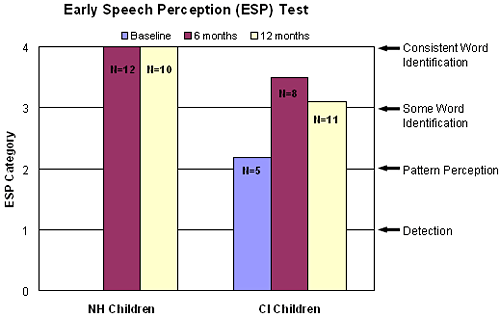
Figure 1. Mean ESP category achieved by normally hearing (NH) and implanted (CI) children completing the first year in the CDaCI study.
For the CDaCI speech recognition protocol, the PSI is typically introduced when the child is 3 years of age or when she or he has achieved category 3 or 4 on the ESP task. Results are expressed as percent-correct identification of words in quiet and of sentences in both quiet and in single-talker competition across message-to-competition ratios (MCR) ranging from +10 to -10 dB. As shown in Figure 2, the NH group achieved mean scores approaching 100% correct identification for both words and sentences in quiet. Results for the CI group (n=4) at baseline revealed a mean word score in quiet of 33%, increasing to 95% at 1-year follow-up (n=5). Mean sentence identification scores in quiet were 45% at baseline for two CI children, improving to 92% for six children at 1-yr follow-up. For the competing conditions (Figure 3), mean scores for the NH group
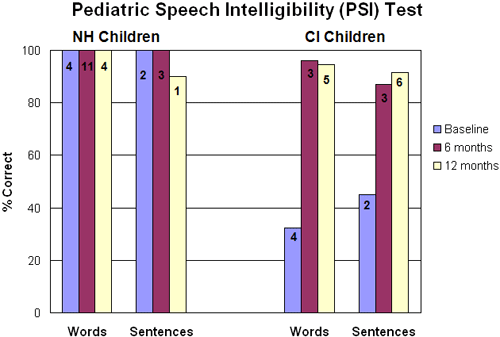
Figure 2. Mean PSI word and sentence identification in the quiet condition for normally hearing (NH) and implanted (CI) children. The numbers on the data bars indicate the number of children that could be assessed for that condition or test interval.
were approximately 100% at +10 dB MCR (the competition is 10 dB lower in intensity than the message) across all intervals. At 0 dB MCR (the message and competition are at equal intensities) mean scores for the NH group ranged between 80% and 98% from baseline to 12 months post, whereas at -10 dB MCR (the competition is 10 dB higher in intensity than the message) they ranged from 60% to 70%. Although, no child in the CI group was able to be tested in the competing conditions at baseline, by 6 months post implant, 2 children could be assessed in competition, achieving 100% correct identification at +10 dB MCR and mean scores of 95% and 50% at 0 dB and -10 dB MCR, respectively. By 12 months post-implant, almost half (n=5) CI children were able to undertake the task, achieving mean scores of 100% at +10 dB MCR, 76% at 0 dB MCR, and 36% at -10 dB MCR.
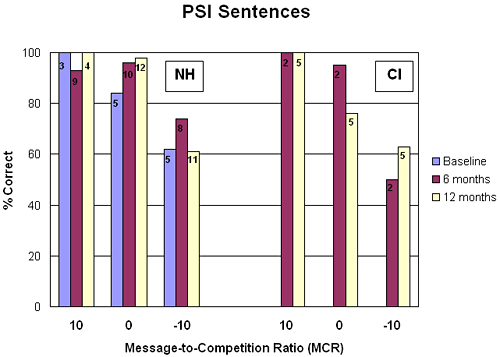
Figure 3. Mean PSI sentence identification scores across three message-to-competition ratios (MCR) for the normal hearing (NH) and implanted (CI) children at baseline, six months and twelve months post implantation. The numbers on the data bars indicate the number of children that could be assessed for that condition or time interval.
New Test Development at the House Ear Institute
A computer interface has recently been developed by Karen Johnson and John Wygonski at the House Ear Institute that computes both reaction time and accuracy scores for the PSI (Johnson, Wygonski, & Eisenberg, 2005). Preliminary data with 7 normally hearing children (ranging in age from 3 yrs 5 mos to 6 yrs 4 mos) showed sentence identification scores between 92.8 and 98.5% across the 0 dB MCR, +10 dB MCR, and Quiet conditions. Identification accuracy fell to 75% at -10 dB MCR. Mean reaction times increased systematically as the listening condition was made more difficult, even when accuracy of identification was close to ceiling. Thus, reaction time data appears to provide a window into the amount of effort it takes to achieve a given level of accuracy as listening conditions change from easy to difficult. Figure 4 shows the sentence MCR function for a 3 year 9 month old hearing-impaired boy who received a cochlear implant at 2 years of age.
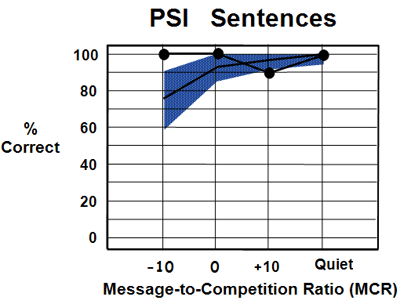
Figure 4. PSI sentence identification for a 3 year 9 month old child at 1 year post-implant in quiet and in three competing conditions. Mean performance for 7 normally hearing children (age range: 3years 5months to 6years 4 months) is shown by the solid black line along with 2 standard errors of the mean (blue shaded region).
It can be seen that he is performing at or close to ceiling across the range of listening conditions. In fact, his performance at the two most difficult MCRs is slightly better than mean performance for the normally hearing sample (solid line on the graph). In Figure 5, this child's reaction time data (shown in maroon) are plotted as a function of MCR along side the mean data for the normally hearing children (shown in blue). Although he achieved 100% correct identification at three out of four MCRs, his reaction times showed the same increase with decreasing MCR that was observed in the normally hearing children. And, although his reaction times are slightly longer than the means of the normally hearing sample, they still tended to fall within 2 standard errors. These data suggest that reaction time might provide additional valuable information about ease of listening beyond that yielded by accuracy scores alone.
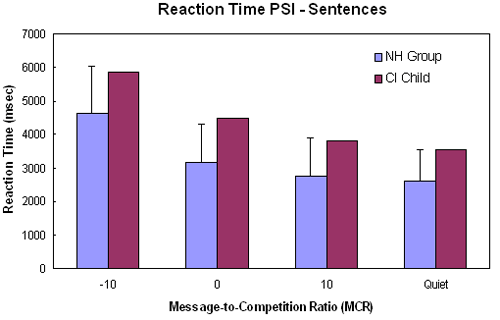
Figure 5. Reaction time for PSI sentence identification for a 3 year 9 month old child 1 year post-implantation in quiet and three competing conditions versus mean reaction times for 7 normally hearing (NH) children (age range: 3 years 5 months to 6 years 4months). Error bars indicate 2 standard errors of the mean for the normal hearing group.
In addition to the new prototype being developed for the PSI, the CARE Center clinical research staff is in the process of compiling a progressive battery of behavioral measures to be used for clinical evaluation of speech perception in very young children with hearing loss. An important component of this battery is the investigation of child response tasks as a function of age. We are using a paradigm in which a set of stimuli (such as vowel-consonant-vowel nonsense syllables) is held constant while the response task is varied for children ranging in age between 6 months and 5 years. Using developmentally appropriate techniques, tasks are designed to assess the perception of phonologically significant contrasts, including vowel height and place and consonant voicing, manner (continuance), and place in the bilabial/alveolar (front) and alveolar-palatal (rear) position. These tasks are derived from the Speech Pattern Contrast Test (SPAC), a forced-choice test of word identification in which the response alternatives are contrasted by one or two phonetic features (Boothroyd, 1984). The tests in the progressive test battery include the VRASPAC (Eisenberg, Martinez, & Boothroyd, 2004), PlaySPAC (under development), On-line IMSPAC (Eisenberg, Martinez, & Boothroyd, 2003; Kosky & Boothroyd, 2003; Martinez, Eisenberg, Boothroyd, & Johnson, 2005), and VIDSPAC (Boothroyd, 1991; Eisenberg, Shannon, Martinez, Wygonski, & Boothroyd, 2000). We will briefly describe the two tests developed specifically for use with toddlers and infants—OLIMSPAC and VRASPAC.
The OLIMSPAC, an on-line implementation of the Imitative Test of Speech Pattern Contrast Perception, was developed for children 3 years of age and older. The test assesses perception of phonologically significant contrasts through the child's imitation of nonsense syllables. The original test was developed for use as a research tool in which the child's imitations were recorded and edited off line for a panel of judges to evaluate (Boothroyd, 1985). This new on-line version is more clinically applicable as the audiologist scores the child's responses while the test is progressing. The test is administered first in the auditory-visual modality and second in the auditory-only modality. The clinician administering the test is masked from hearing and seeing the target stimuli, thus making it a more objective measure. An example of results from a 3-year-old child with a cochlear implant is shown in Figure 6. The composite score is higher in the auditory-visual modality relative to auditory-only, and performance in both modalities is significantly above chance. In the auditory-only modality, the child has access to vowel height and place as well as consonant voicing and front place (bilabial/alveolar).
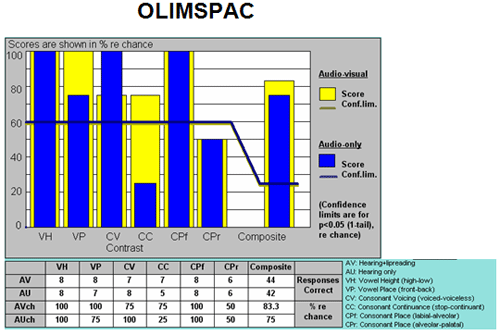
Figure 6. On-line Imitative Test of Speech Pattern Contrast Perception (OLIMSPAC) results for a 3-year-old child with a cochlear implant. The yellow bars indicate the auditory-visual presentation and blue bars the auditory-only presentation.
Another new test in the progressive test battery is developed specifically for infants—the VRASPAC (Visual Reinforcement Assessment of the Perception of Speech Pattern Contrasts). The VRASPAC combines the Visual Reinforcement Infant Speech Discrimination (VRISD) Test (Eiler, Wilson, & Moore, 1977), the change/no paradigm (Sussman & Carney, 1989) and the speech pattern contrast concept (Boothroyd, 1984). In essence, the infant is conditioned to respond to a phonetic change using a head-turn response. In administering the VRASPAC, the standard syllable is presented repeatedly (e.g., "oodoo, oodoo, oodoo, oodoo, ...") until the child habituates to the standard. The tester then presents the contrast stimulus such as vowel height ("aadaa, aadaa, aadaa, aadaa...") and the child is trained to turn his or her head toward the reinforcer (either an animated toy or a cartoon on a computer monitor). The data are analyzed on-line to provide estimates of the probability of a correct response for a phonetic contrast as well as the level of confidence that the responses are not random. Early results (Eisenberg, Martinez, & Boothroyd, 2004) indicate that infants with normal hearing are able to respond with a high level of confidence to each of the contrasts. Infants with hearing loss have shown consistent response to vowel height only. Though preliminary, these results suggest that performance by infants with hearing loss may be dependent on their level of phonological development and/or the salience of the acoustic change.
Conclusion
With the implementation of newborn hearing screenings and earlier identification of hearing loss across the country, there is increased interest in measures with which to assess the auditory abilities of infants and toddlers. The need to develop new test batteries is particularly relevant now that children are being identified with hearing loss in infancy. We have presented a summary of those measures that we have found to be useful for children ages 3 years and younger, as well as new assessment tools under development.
Acknowledgments
We wish to acknowledge Arthur Boothroyd, John Wygonski, and Carol Cokely for their contributions to this work. The research reported in this manuscript was supported by grants R01DC006238 (House Ear Institute), R01DC004433 (UCLA School of Medicine), R01DC00064 (Indiana University School of Medicine), and R01DC004797 (Johns Hopkins University School of Medicine) awarded from the National Institute on Deafness and Other Communication Disorders of the National Institutes of Health, as well as a grant from the National Organization for Hearing Research (House Ear Institute).
References
Barker, B.A., & Bass-Ringdahl, S.M. (2004). The effect of audibility on audio-visual speech perception in infant cochlear implant recipients. In R.T. Miyamoto (Ed.), Cochlear Implants. International Congress Series 1273 (pp. 316-319). Amsterdam: Elsevier.
Barker, B.A., & Tomblin, J.B. (2004). Bimodal speech perception in infant hearing and cochlear implant users. Archives of Otolaryngology - Head & Neck Surgery, 130, 582-587.
Boothroyd, A. (1984). Auditory perception of speech contrasts by subjects with sensorineural hearing loss. Journal of Speech and Hearing Research, 27, 134-144.
Boothroyd, A. (1985). Evaluation of speech production in the hearing-impaired: Some benefits of forced-choice testing. Journal of Speech and Hearing Research, 28, 185-196.
Boothroyd, A. (1991). Speech perception measures and their role in the evaluation of hearing aid performance in a pediatric population. In J.A. Feigin and P.G. Stelmachowicz (Eds.), Pediatric Amplification: Proceedings of the 1991 National Conference (pp.77-91). Omaha, Nebraska: Boys Town National Research Hospital.
Boothroyd, A. (2004). Measuring auditory speech perception capacity in very young children. In R.T. Miyamoto (Ed.), Cochlear Implants. International Congress Series 1273 (pp. 292-295). Amsterdam: Elsevier.
Eilers, R.E., Wilson, W.R., & Moore, J. M. (1977). Developmental changes in speech discrimination in infants. Journal of Speech and Hearing Research, 20, 766-780.
Eisenberg, L.S., Johnson, K.J., Martinez, A.S., Cokely, C.G., Quittner, A.L., Tobey, E.A., Wang, N-Y., Fink, N.E., Niparko, J.K., & the CDaCI Investigative Team (2005). 10th Symposium on Cochlear Implants in Children, Dallas, TX, March 15-19.
Eisenberg, L.S., Martinez, A.S., & Boothroyd, A. (2003). Auditory-visual and auditory-only perception of phonetic contrasts in children. The Volta Review, 103, 327-346.
Eisenberg, L.S., Martinez, A.S., & Boothroyd, A. (2004). Perception of phonetic contrasts in infants: Development of the VRASPAC. In R.T. Miyamoto (Ed.), Cochlear Implants. International Congress Series 1273 (pp. 364-367). Amsterdam: Elsevier.
Eisenberg, L.S., Shannon, R.V., Martinez, A.S., Wygonski, J., & Boothroyd, A. (2000). Speech recognition with reduced spectral cues as a function of age. Journal of the Acoustical Society of America, 107, 2704-2710.
Elliott, L.L., & Katz, D. (1980). Development of a new children's test of speech descrimination (Technical Manual). St. Louis, MO: Auditec.
Franz, D.C., Caleffe-Schenck, N., & Kirk, K.I. (2005). A tool for assessing functional use of audition in children: Results in children with the MED-EL COMBI 40+ cochlear implant system. The Volta Review, 104, 175-196.
Houston, D..M., Pisoni, D.B., Kirk, K.I., Ying, E.A., & Miyamoto, R.T. (2003). Speech perception skills of deaf infants following cochlear implantation. A first report. International Journal of Pediatric Otorhinolaryngology, 67, 479-495.
Houston, D. M., Ying, E. A., Pisoni, D.P., & Kirk, K.I. (2003). Development of pre-word-learning skills in infants with cochlear implants. The Volta Review, 103, 303-326.
Jerger, S., & Jerger, J. (1984). Pediatric Speech Intelligibility Test. St. Louis: Auditec of St. Louis.
Johnson, K.C., Wygonski, J.J. & Eisenberg, L.S. (2005). Choice reaction time (CRT) in assessing pediatric word and sentence recognition. 10th Symposium on Cochlear Implants in Children, Dallas, TX, March 15-19.
Kishon-Rabin, L. Taitelbaum-Swead, R., Ezrati-Vinacour, R., Kronnenberg, J., & Hildesheimer, M. (2004). Pre-first word vocalizations of infants with normal hearing and cochlear implants using the PRISE. In R.T. Miyamoto (Ed.), Cochlear Implants. International Congress Series 1273 (pp. 360-363). Amsterdam: Elsevier.
Kosky, C., & Boothroyd, A. (2003). Validation of an on-line implementation of the Imitative Test of Speech Pattern Contrast Perception (IMSPAC). Journal of the American Academy of Audiology, 14, 72-83.
Kuhl, P.A., (1992). Psychoacoustics and speech perception: internal standards, perceptual anchors, and prototypes. In L.A. Werner and E.W. Rubel (Eds.). Developmenal psychoacoustics (Chapter 12, pp. 293-332). Washington D.C.: American Psychological Association.
Jusczyk, P.W., & Luce, P.A. (2002). Speech perception and spoken word recognition: Past and present. Ear and Hearing, 23, 2-40.
Ling, A.H. (1977). Schedules of development in audition speech language communication for hearing-impaired infants and their parents. Washington, D.C.: The Alexander Graham Bell Association for the Deaf, Inc.
Luxford, W.M., Eisenberg, L.S., Johnson, K.C., & Mahnke, E. (2004). Cochlear implantation in infants younger than 12 months. In R. Miyamoto (Ed.), Proceedings of the 8th International Cochlear Implant Conference. International Congress Series, Vol. 1273 (pp. 376-379) .Netherlands: Elsevier.
Martinez, A.S., Eisenberg, L.S., Boothroyd, A., & Johnson, K.C. (2005). Auditory-visual and auditory-only perception of CV and VCV stimuli in young children. 10th Symposium on Cochlear Implants in Children, Dallas, TX, March 15-19.
Sussman, J.E., & Carney, A.E. (1989). Effects of transition length on the perception of stop consonants by children and adults. Journal of Speech and Hearing Research, 32, 151-160.
Werker, J.F., & Tees, R.C. (1999). Influences on infants speech perception processing: Toward a new synthesis. Annual Review of Psychology, 50, 509-535.
Zimmerman-Phillips, S., Robbins, A.M., & Osberger, M.J. (2000). Assessing cochlear implant benefit in very young children. Annals of Otology, Rhinology, and Laryngology, 109 (Supplement 185), 42-43.

